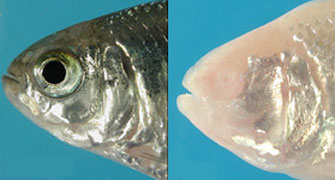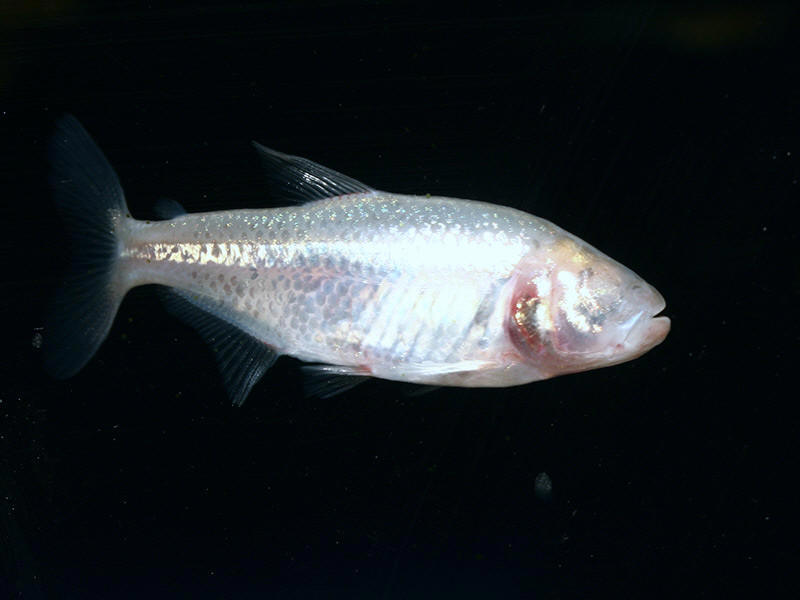How am I different from my ancestors? (Morphology)
The Blind Cavefish has made many adaptations to its dark cave life. It has also allowed scientists to be able to loo at evolution in action. Using the cavefish, they were able to show for the first time, in nature, how inherited gene variations that show no physical difference (known as standing or cryptic genes), can spontaneously create a physical difference with the introduction of a new environment.

The most noticeable physical adaptation that has been observed of this nature is the loss of functional eyes in the Blind Cavefish, hence the title "blind". The environmental change that prompted the loss of eyes is argued to be when the A. jordani's surface dwelling, fully functional eyed ancestors, found themselves trapped inside a cave approximately, 2 or 3 million years ago (McPhearson, 2014). Bigger eyes are useful for surface dwellers, animals that have access to a light source; But once entered into the cave setting, it doesn't matter if the organism possesses big or small eyes since the environment is completely dark.
This evolutionary trait didn't occur over the course of a few generations. The process was slow, beginning with the appearance of smaller eyes than the previous generations. The new generation of fish are born with these smaller sized eyes, but within a few weeks of maturing, the eyes degenerate and are reabsorbed back into the body. This trait was selected for because it proved an adaptive advantage by allowing the Blind Cavefish to save a large amount of energy that is taken up to create and maintain a functional eye, and this allows them to spend that energy on traits that would
 better suit the
Cavefish in a dark environment(sciencedaily, 2013). Because these fish
lack eyesight they generally rely on olfactory and chemical sensory
to know what surrounds them. Another organism, the Walleye, also has
a keen sense of smell under the water. Although the Walleye has full
eyesight, this shows that keen olfactory senses can converge in many
different lineages. If you want to learn more about Walleyes, click
HERE.
better suit the
Cavefish in a dark environment(sciencedaily, 2013). Because these fish
lack eyesight they generally rely on olfactory and chemical sensory
to know what surrounds them. Another organism, the Walleye, also has
a keen sense of smell under the water. Although the Walleye has full
eyesight, this shows that keen olfactory senses can converge in many
different lineages. If you want to learn more about Walleyes, click
HERE.
It has been shown in recent studies that eye development could be stimulated within this blind specimen. When lenses of seeing fish were transplanted into the Blind Cavefish, it started to develop an eye. Further studies need to be conducted with hopes that this event may be useful while treating blindness in humans (Jeffery W. et. al, 2003).
Another great adaptation that is found within the Astyanax species is that they are completely void of pigmentation. They are born with a pinkish hue, but as they become older they will give off an iridescent sheen. The main purpose of melanin pigmentation within organisms is to protect the outer layer of skin from damage by UV light, and it also plays a role in things such as vision, camouflage, and mimicry. Because this species lives in a pitch-black world, the possession of melanin pigmentation would be completely useless. In most albino animal cases, it is shown that the animal has reduced fitness compared to its pigmented counterpart. However, selection for pigmentation is not prominent while living in a dark cave, which results in a multitude of colorless species. The A.jordani's ancestor the A.mexicanus, which has pigmented surface-dwelling forms and also cave dwelling forms, posses traits that evolved independently several times. This is shown by some fish of this species being considered only partially albino, with a reduced amount of melanin pigmentation (Bilandzija 2013). Although it does not belong to the same genus as the Blind Cave Fish, the Ozark Cavefish is also known to lack pigmentation on its body. This trait can be considered "convergent" because it has evolved in different lineages based on specific factors; in this case, its habitat. To read more about the similarities between these two freshwater species, click HERE.